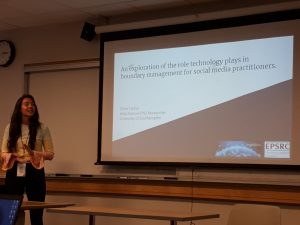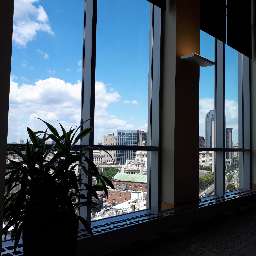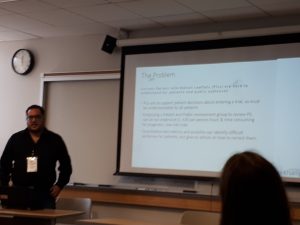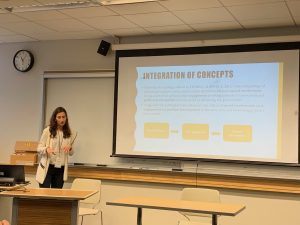WebSci’19 Conference, Boston
Chira Tochia
Although many of those attending the PhD symposium were from the Web Science CDT, I was still very excited to see everyones presentations as it is easy to get lost in your own work and forget how helpful it is to share ideas and watch how others present their work in its current state. I’ll admit I was a little bit nervous even though I love presenting – I find it much easier than writing personally but I wasn’t sure who was in attendance exactly and I started to think everyone was going to have flawless presentations and perfectly analysed data. The reality though was we were all at different stages of our PhD life cycle and we all were looking for some guidance or feedback from our peers. Even topics that were completely unrelated to my area of research were useful whether that be the way they attacked their methodology or hurdles they had to jump to get approval for their ethics. My presentation was last of the day – possibly the worst spot – however, everyone was still very engaged and asked many questions (which I’m extremely grateful for, especially after lunch). Presenting is always a valuable experience but I really felt the benefit of this symposium, not only presenting my latest findings into a concise argument but hearing from other students too, I was even recommended some really useful papers to read!
than writing personally but I wasn’t sure who was in attendance exactly and I started to think everyone was going to have flawless presentations and perfectly analysed data. The reality though was we were all at different stages of our PhD life cycle and we all were looking for some guidance or feedback from our peers. Even topics that were completely unrelated to my area of research were useful whether that be the way they attacked their methodology or hurdles they had to jump to get approval for their ethics. My presentation was last of the day – possibly the worst spot – however, everyone was still very engaged and asked many questions (which I’m extremely grateful for, especially after lunch). Presenting is always a valuable experience but I really felt the benefit of this symposium, not only presenting my latest findings into a concise argument but hearing from other students too, I was even recommended some really useful papers to read!
I can’t recommend pushing yourself to submit papers for the chance to present enough. I thought I wasn’t in a place to be presenting my research but if anything this has really helped me move my research forward.
Clare Walsh
One of the highlights for everyone was the key note from Fabien Gandon. Fabien heads up a large international interdisciplinary team at the Universté Côte d’Azur. His talk reminded the audience of many of the reasons ambivalence is not an acceptable response to the future of web-based technologies. From the environmental impact of deploying complicated analysis, to the web of animals to produce better-informed decisions, his talk was wide-ranging. At the heart was the reminder that there are dangers when human behaviour can be predicted and manipulated. His solution to the challenges of the WWW is the MMM – Massively Multi-disciplinary Method. For me, from an education background, the best example of this was the CREEP EU project to predict where children are being bullied online through classification technology, and to intervene at an early stage. The education community has been struggling with this, and has wanted a simple ‘Help is coming’ for so long.
Fernando Santos-Sanchez
The Current Price of Using the Web
A few days ago, I was fortunate enough to participate in the WebSci’19 conference at the North-eastern University in Boston USA. One of the most insightful parts of the conference was the 2nd day sessions on user behaviour on the Web. The analysis presented in this sessions engaged the public on realising just how much information is being took from us and how it is currently being used. 
The most common approach to user consent on the top 500 most visited Websites by Google, which included many news websites, was that users must completely cede their information to be granted use of their sites, and in many cases did not inform the user on all the parties that were granted access to their data or how these organisations will use the collected information. A shocking example was given by Tim Libert on Oracle’s Bluekai, which commonly collected data from these top 500 websites on each of us and complemented it with offline sources from associated physical stores, loyalty card programs, and mobile apps to the point that they usually have multiple avenues to identify the users, e.g. email accounts, unique ids of your phone or laptop, name, address, and electronic transactions.These sessions have made reflect on just how much of my identity I am prepared to exchange in order to use the Web. While understanding that sharing my data is what makes possible apps like Google traffic maps and disease trends, I must question the need and wisdom of permitting large companies to centralise the current amount of user information on regards to the inherent risks these practices involve to the Web users’ rights of privacy and freedom.
Justyna Jonak
I enjoyed attending the poster session on Monday, 1st July and being able to learn about some fascinating research from around the world. As a researcher using mainly qualitative methods, I was a bit concerned that computational approaches will heavily dominate this conference, and I was not sure how I am going to fit with my research. I was wrong. First of all, other  researchers were using qualitative study, for example, interviews with the people aged over 65 from India and their perspective on sharing misinformation in the Indian context. Secondly, much of researchers acknowledged some need for qualitative study in their research designs.This session and the posters presented have shown that Web Scientists seems to be now mostly concerned with the spread of misinformation around the Web, and finding the right tools to fight with this trend. It was interesting to have some discussion with some of them, mainly when I could refer to my preliminary findings and suggesting that technological solutions will be not enough, as long as there are still people who share misinformation and believe in them. We also discussed how the education of people, in this case, is essential. There was one group of researchers who designed a tool for people to check how susceptible are for sharing misinformation. We had a good discussion in trying to understand how this tool will be a benefit for the public.
researchers were using qualitative study, for example, interviews with the people aged over 65 from India and their perspective on sharing misinformation in the Indian context. Secondly, much of researchers acknowledged some need for qualitative study in their research designs.This session and the posters presented have shown that Web Scientists seems to be now mostly concerned with the spread of misinformation around the Web, and finding the right tools to fight with this trend. It was interesting to have some discussion with some of them, mainly when I could refer to my preliminary findings and suggesting that technological solutions will be not enough, as long as there are still people who share misinformation and believe in them. We also discussed how the education of people, in this case, is essential. There was one group of researchers who designed a tool for people to check how susceptible are for sharing misinformation. We had a good discussion in trying to understand how this tool will be a benefit for the public.
Sofia Kitromili
A few months ago Web Science CDT students were given the opportunity to attend the 2019 ACM Web Science Conference in Boston, USA should our paper submissions be accepted. I thought: USA, and the chance to attend a Conference I had never previously attended is not an opportunity to take lightly. Luckily, my paper had been accepted alongside the papers of a couple other colleagues so we made this a group trip and went to Boston to present our work.
I took part as a presenter in the PhD Symposium which had a fairly relaxed atmosphere and a handful of people there to present or give feedback. I found the experience stress relieving in any future endeavours of mine to present the work which I thought mattered mostly to me and my supervisors, yet I was proven wrong! My work, they said “is valuable because nobody else has ever looked at this issue the way you are attempting to” and who doesn’t like to hear that about their work. What made the session even better were the enormous sizes of pizza boxes we were served for lunch and the plate exceeding pizza slices we enjoyed.
Throughout the conference sessions, which took place in Northeastern University, a lovely campus with really tall buildings and mesmerizing views; I heard about eminent Web Science topics that although resident in a Web Science institute had never heard of before. Topics such as trolls, Trump, and Pokemons are certainly topics I did not expect to encounter. Yet I did, and that only proved how extensive and elaborate the research of the Web can be. Aside from the interesting topics and the Boston views it is not to be dismissed that travelling to USA for a foodie like me meant burgers, lobster rolls, donuts and basically anything edible that the US is famous for. I was too excited to come across places which I’ve known for long but never had the chance to visit because they are only native in the US. Thanks to the Web Science admin staff, I think the best place we visited for food must have been Cheers, a bar that apparently inspired an old TV Show with the same name which I had no idea about. It was nice to be there and the meatball sub I ordered was certainly worthy.
Keisha Taylor
The local, historical and cultural in Web Science: Reflections on WebSci19
I emerged from Boston Logan International airport for WebSci19 in search of transport to find taxis, but no people on one end of the taxi rank. On the other end, there were a lot of people waiting for a taxi, but there were no taxis. They were all waiting for an Uber or a Lyft. When I go to a new city, I love to take a moment to just sit and gaze as people go by. The lovely hot Boston weather offered up the chance at the end of one conference day. Many people were wearing airpods, seemingly unaware of their surroundings. Maybe they were talking to someone far away, or maybe the person they were talking too was just around the corner. Maybe that woman was listening to a podcast, or was it music? I wondered what would happen if I stopped them to find out … for research purposes … to find out not just what, but why.
